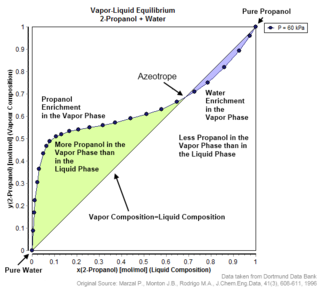
An azeotrope or a constant boiling point mixture is a mixture of two or more liquids whose proportions cannot be altered or changed by simple distillation. This happens because when an azeotrope is boiled, the vapour has the same proportions of constituents as the unboiled mixture. Because their composition is unchanged by distillation, azeotropes are also called constant boiling point mixtures.
Chloroform, or trichloromethane, is an organic compound with formula CHCl3. It is a colorless, strong-smelling, dense liquid that is produced on a large scale as a precursor to PTFE. It is also a precursor to various refrigerants. It is one of the four chloromethanes and a trihalomethane. It is a powerful anesthetic, euphoriant, anxiolytic and sedative when inhaled or ingested.

Iodoform (also known as triiodomethane and, inaccurately, as carbon triiodide) is the organoiodine compound with the formula CHI3. A pale yellow, crystalline, volatile substance, it has a penetrating and distinctive odor (in older chemistry texts, the smell is sometimes referred to as that of hospitals, where the compound is still commonly used) and, analogous to chloroform, sweetish taste. It is occasionally used as a disinfectant.

John Snow was an English physician and a leader in the development of anaesthesia and medical hygiene. He is considered one of the founders of modern epidemiology, in part because of his work in tracing the source of a cholera outbreak in Soho, London, in 1854, which he curtailed by removing the handle of a water pump. Snow's findings inspired the adoption of anaesthesia as well as fundamental changes in the water and waste systems of London, which led to similar changes in other cities, and a significant improvement in general public health around the world.

Bromoform (CHBr3) is a brominated organic solvent, colorless liquid at room temperature, with a high refractive index, very high density, and sweet odor is similar to that of chloroform. It is a trihalomethane, and is one of the four haloforms, the others being fluoroform, chloroform, and iodoform. Bromoform can be prepared by the haloform reaction using acetone and sodium hypobromite, by the electrolysis of potassium bromide in ethanol, or by treating chloroform with aluminium bromide. Currently its main use is as a laboratory reagent.

Sir James Young Simpson, 1st Baronet, FRCPE was a Scottish obstetrician and a significant figure in the history of medicine. He was the first physician to demonstrate the anaesthetic properties of chloroform on humans and helped to popularise its use in medicine.
Trihalomethanes (THMs) are chemical compounds in which three of the four hydrogen atoms of methane (CH4) are replaced by halogen atoms. Many trihalomethanes find uses in industry as solvents or refrigerants. THMs are also environmental pollutants, and many are considered carcinogenic. Trihalomethanes with all the same halogen atoms are called haloforms. Several of these are easy to prepare through the haloform reaction.
Dichlorocarbene is the reactive intermediate with chemical formula CCl2. Although this chemical species has not been isolated, it is a common intermediate in organic chemistry, being generated from chloroform. This bent diamagnetic molecule rapidly inserts into other bonds.

The Reimer–Tiemann reaction is a chemical reaction used for the ortho-formylation of phenols; with the simplest example being the conversion of phenol to salicylaldehyde. The reaction was discovered by Karl Reimer and Ferdinand Tiemann. The Reimer in question was Karl Reimer (1845-1883) not the less known Carl Ludwig Reimer (1856-1921).

Butamben is a local anesthetic. It is the ester of 4-aminobenzoic acid and butanol. A white, odourless, crystalline powder. that is mildly soluble in water and soluble in alcohol, ether, chloroform, fixed oils, and dilute acids. It slowly hydrolyses when boiled with water. Synonyms include Butamben, Butilaminobenzoato, and Butoforme. Proprietary names includes Alvogil in Spain and Alvogyl in Switzerland. It is one of three components in the topical anesthetic Cetacaine.

Isoamyl alcohol is a colorless liquid with the formula C
5H
12O, specifically (H3C–)2CH–CH2–CH2–OH. It is one of several isomers of amyl alcohol (pentanol). It is also known as isopentyl alcohol, isopentanol, or (in the IUPAC recommended nomenclature) 3-methyl-butan-1-ol. An obsolete name for it was isobutyl carbinol.

"What Difference Does It Make?" is a song by the English rock band the Smiths, written by singer Morrissey and guitarist Johnny Marr. It was the band's third single and is featured on their debut album, The Smiths. A different version, recorded for the John Peel Show on BBC Radio 1, is included in the compilation album Hatful of Hollow.

Acid guanidinium thiocyanate-phenol-chloroform extraction is a liquid–liquid extraction technique in biochemistry. It is widely used in molecular biology for isolating RNA. This method may take longer than a column-based system such as the silica-based purification, but has higher purity and the advantage of high recovery of RNA: an RNA column is typically unsuitable for purification of short RNA species, such as siRNA, miRNA, gRNA and tRNA.
Deuterated chloroform (CDCl3), also known as chloroform-d, is an isotopically enriched form of chloroform (CHCl3) in which most its hydrogen atoms consist of the heavier nuclide deuterium (heavy hydrogen) (D = 2H) rather than the natural isotopic mixture in which protium (1H) is predominant. Deuterated chloroform is by far the most common solvent used in NMR spectroscopy. While dichloromethane and chloroform (trichloromethane) are both commonly used solvents that dissolve a wide range of other organic compounds, deuterated chloroform is more easily produced and much less expensive than deuterated dichloromethane. In addition, it is chemically unreactive and unlikely to exchange its deuterium with its solute, and its low boiling point allows for easy sample recovery.

Joseph Thomas Clover was an English doctor and pioneer of anaesthesia. He invented a variety of pieces of apparatus to deliver anaesthetics including ether and chloroform safely and controllably. By 1871 he had administered anaesthetics 13,000 times without a fatality.

The haloform reaction is a chemical reaction where a haloform (CHX3, where X is a halogen) is produced by the exhaustive halogenation of a methyl ketone (RCOCH3, where R can be either a hydrogen atom, an alkyl or an aryl group), in the presence of a base. The reaction can be used to transform acetyl groups into carboxyl groups or to produce chloroform (CHCl3), bromoform (CHBr3), or iodoform (CHI3).

Caylee Marie Anthony was an American girl who lived in Orlando, Florida, with her mother, Casey Marie Anthony, and her maternal grandparents, George and Cindy Anthony. On July 15, 2008, she was reported missing in a 9-1-1 call made by Cindy, who said she had not seen Caylee for 31 days and that Casey's car smelled like a dead body had been inside it. Cindy said Casey had given varied explanations as to Caylee's whereabouts before finally telling her that she had not seen Caylee for weeks. Casey lied to detectives, telling them Caylee had been kidnapped by a nanny on June 9, and that she had been trying to find her, too frightened to alert the authorities. She was charged with first-degree murder in October 2008 and pleaded not guilty.
ACE mixture is an historical anaesthetic agent for general anaesthesia. It was first suggested by George Harley and first used in England around 1860. In 1864 it was recommended for use by the Royal Medical and Surgical Society's Chloroform Committee. It was rarely used after the 19th century, except in Germany, where it was used for slightly longer.
Phenol–chloroform extraction is a liquid-liquid extraction technique in molecular biology used to separate nucleic acids from proteins and lipids.

"Chloroform" is a song written and performed by Phoenix, issued as the first promotional single from the band's fifth studio album Bankrupt!. The official remix of the song features noise pop band Sleigh Bells.













